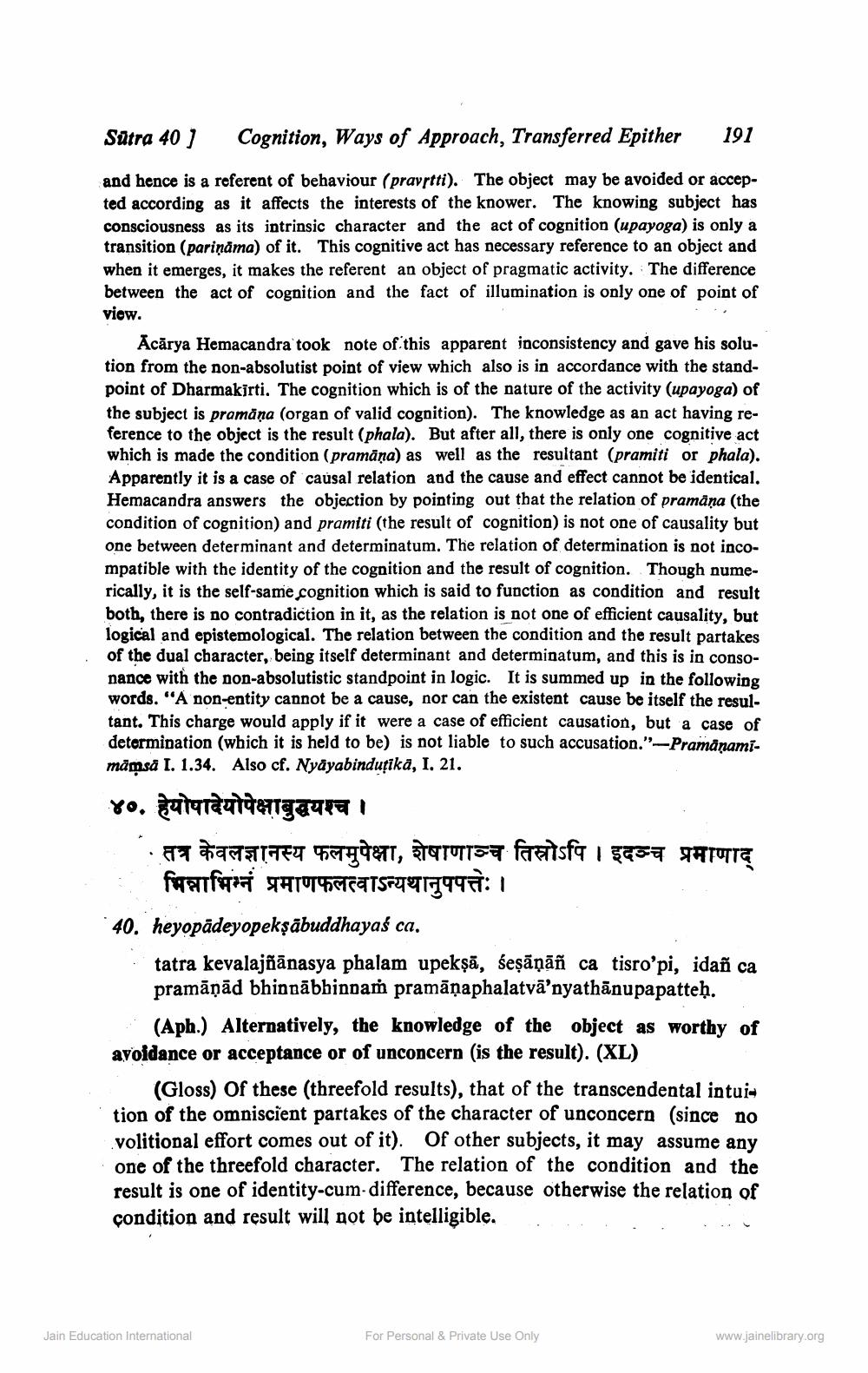________________
Sätra 40 ) Cognition, Ways of Approach, Transferred Epither 191 and hence is a referent of behaviour (pravstti). The object may be avoided or accepted according as it affects the interests of the knower. The knowing subject has consciousness as its intrinsic character and the act of cognition (upayoga) is only a transition (pariņāma) of it. This cognitive act has necessary reference to an object and when it emerges, it makes the referent an object of pragmatic activity. The difference between the act of cognition and the fact of illumination is only one of point of view.
Ācārya Hemacandra took note of this apparent inconsistency and gave his solution from the non-absolutist point of view which also is in accordance with the standpoint of Dharmakirti. The cognition which is of the nature of the activity (upayoga) of the subject is pramāņa (organ of valid cognition). The knowledge as an act having reference to the object is the result (phala). But after all, there is only one cognitive act which is made the condition (pramāņa) as well as the resultant (pramiti or phala). Apparently it is a case of causal relation and the cause and effect cannot be identical. Hemacandra answers the objection by pointing out that the relation of pramana (the condition of cognition) and pramiti (the result of cognition) is not one of causality but one between determinant and determinatum. The relation of determination is not incompatible with the identity of the cognition and the result of cognition. Though numerically, it is the self-same cognition which is said to function as condition and result both, there is no contradiction in it, as the relation is not one of efficient causality, but logical and epistemological. The relation between the condition and the result partakes of the dual character, being itself determinant and determinatum, and this is in consonance with the non-absolutistic standpoint in logic. It is summed up in the following words. "A non-entity cannot be a cause, nor can the existent cause be itself the resultant. This charge would apply if it were a case of efficient causation, but a case of determination (which it is held to be) is not liable to such accusation."--Pramānamimämsä I. 1.34. Also cf. Nyayabindufika, I. 21.
yo. gutaratdergampai
• तत्र केवलज्ञानस्य फलमुपेक्षा, शेषाणाञ्च तिस्रोऽपि । इदञ्च प्रमाणाद
भिन्नाभिन्नं प्रमाणफलत्वाऽन्यथानुपपत्तेः। -40, heyopādeyopeksābuddhayaś ca.
tatra kevalajñānasya phalam upekşā, śeşāņāñ ca tisro'pi, idañ ca pramāṇād bhinnābbinnaṁ pramāṇaphalatvā’nyathānupapatteủ.
(Aph.) Alternatively, the knowledge of the object as worthy of avoidance or acceptance or of unconcern is the result). (XL)
(Gloss) of these threefold results), that of the transcendental intuis tion of the omniscient partakes of the character of unconcern (since no volitional effort comes out of it). Of other subjects, it may assume any one of the threefold character. The relation of the condition and the result is one of identity-cum-difference, because otherwise the relation of condition and result will not be intelligible.
Jain Education International
For Personal & Private Use Only
www.jainelibrary.org




